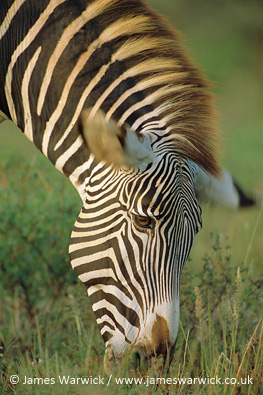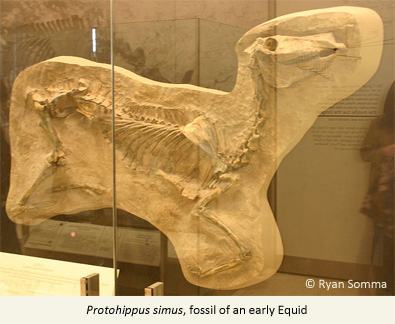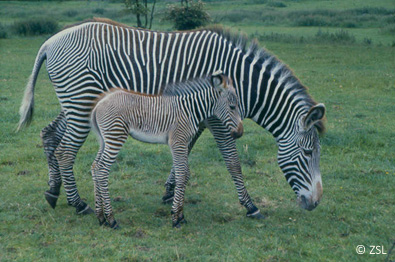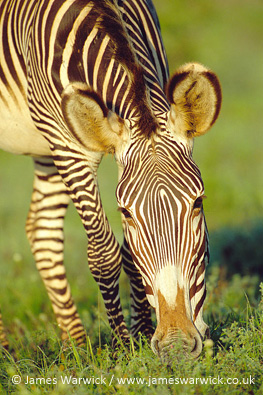Grévy’s zebra (Equus grevyi), ranked 82nd out of all mammals as an EDGE conservation priority, is today’s IUCN Species of the Day. The largest of the living wild horse family, Grévy’s zebra can be distinguished from the other zebras by its larger ears and narrower stripes. In recent history, the species has undergone one of the most substantial reductions of range of any African mammal.

Zebras belong to the Equid (horse) family, part of the group of the herbivorous odd-toed ungulates (Order – Perissodactyla) which also includes rhinoceroses and tapirs.
The first horses appeared in North America in the early Eocene, around 56 million years ago, when the northern supercontinent of Laurasia was beginning to break up, with Europe, Greenland and North America drifting apart. These animals were the size of small dogs and had several toes on each foot, unlike the single hoofs of modern horses, and were browsers that lived in forests and savannas.
During the Miocene epoch (25-8 mya) climate change led to a reduction in the amount of forest cover and an increase in grassland. This was a time of great evolutionary change for the early Equids, with many groups evolving larger body sizes and adapting to a grazing lifestyle. Horse diversity peaked in the mid-Miocene (11-9.5 mya), with more than a dozen different genera of many different sizes evolving.
Since that time horse diversity has gradually decreased, with all forms becoming extinct with the exception of the modern horse genus, Equus. This genus first evolved in North America during the Pliocene epoch (4.5 to 1.8 million years ago), in a time when continental drift led South America to join with North America, and formed the Mediterranean sea.
Members of this successful genus spread throughout Asia, Europe, Africa and South America, but in the late Pleistocene (around 12,000 years ago) a set of devastating extinctions killed off the horses, along with most other large mammals in North and South America. Today, wild horses are found only in parts of Africa and Asia.
Grévy’s zebra used to occur throughout northern Kenya and into Somalia and Ethiopia, to the coast of Eritrea and Djibouti. Today, northern Kenya is the species’ stronghold, and there are three small and isolated populations in Ethiopia. There may be a few individuals surviving in the Sudan.
The population has suffered immense declines; towards the end of the 1970s, the total wild population of Grévy’s zebra was estimated to be approximately 15,000 animals, but by 2002 only 3,000-3,500 animals were thought to survive (representing a 75 percent decline in numbers). In Ethiopia the situation is even worse with a 93 percent decline in numbers. Recent estimates indicate that globally, there may now be as few as 1700-2000 animals left in the wild.
Declines in modern times are mainly due to hunting for the skin of Grévy’s zebra, which was sought by hunters either as trophies or for export for use in the fashion markets of Europe and North America. There is no evidence of killing for skins since the species was listed on CITES Appendix I in 1979, although it may continue to be hunted for its meat in some areas.
The main threats to the species today are habitat loss and degradation. This is primarily due to overgrazing by domestic livestock, which alters vegetation structure and reduces the availability of forage. Access to water is limited, particularly during the dry season, due to the effect of irrigation schemes in highland areas and the exclusion of wildlife from water sources (this has occurred as a result of pastoralists becoming more sedentary around permanent and seasonal water sources). The animals must therefore compete with pastoral people and their livestock for water as well as food. The increasingly long distances that zebras now have to travel between suitable grazing areas and water sources are thought to be having a detrimental effect on breeding rates and infant survival.
However, a number of conservation measures are in place for this species, including management of protected areas, establishment of local wildlife conservancies, and long-term research and monitoring. If these efforts continue, Grévy’s zebra will hopefully be with us for many more years to come.
To support the EDGE of Existence conservation programme for unique and threatened species, please donate here or become an EDGE Champion.



